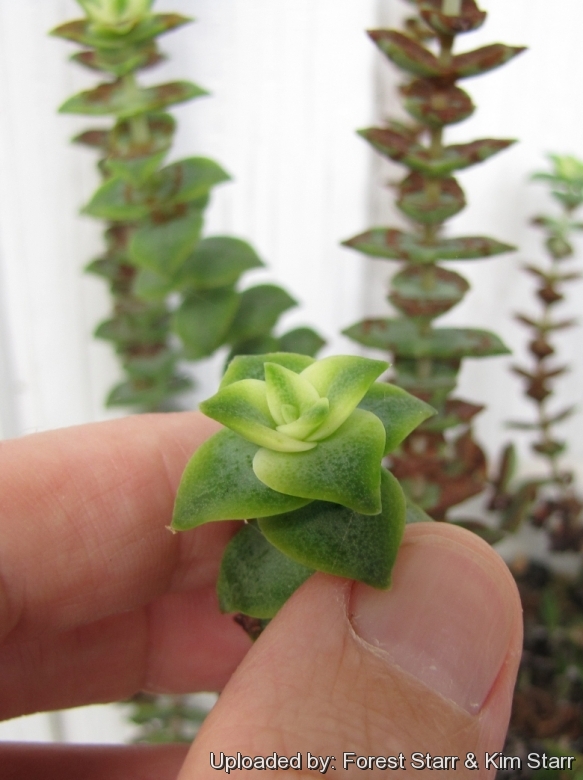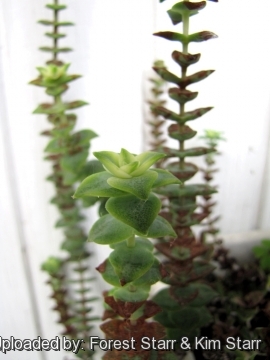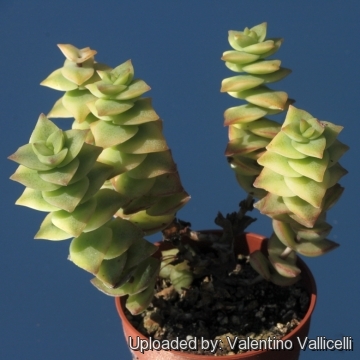Accepted Scientific Name: Crassula perforata Thunb.
Nova Acta Phys.-Med. Acad. Caes. Leop.-Carol. Nat. Cur. 6: 319 1778

Crassula perforata f. variegata Photo by: Forest Starr & Kim Starr
Leaves at Ulana St Makawao, Maui, Hawaii (USA). February 18, 2011.
Origin and Habitat: Garden origin (Nursery produced cultivar). The original natural habitat of this species is the South and Eastern Cape Province of South Africa north to Natal eastwards to central KwaZulu-Natal.
Synonyms:
See all synonyms of Crassula perforata
back
Accepted name in llifle Database:Crassula perforata Thunb.Nova Acta Phys.-Med. Acad. Caes. Leop.-Carol. Nat. Cur. 6: 319 1778Synonymy: 11
Accepted name in llifle Database:Crassula perforata subs. kougaensis van Jaarsv. & A.E.van WykAloe 46(1): 22 (-23; figs., map). 2009
back
Common Names include:
ENGLISH: Variegated necklace vine, Variegated String of Buttons, Variegated pagoda plant
CHINESE (中文): 十字星锦
Description: The 'Variegated Necklace Vine' (Crassula perforata f. variegataSN|21901]]SN|27402]]) is a is a nice variegated form of Crassula perforataSN|27402]]SN|21901]] a stacked and compact scrambling succulent shrublet that stays relatively low and clumps readily. Leaves have frosty green midstripes and yellow-cream variegation which fades as the older foliage matures, but reversion to the green form are not unusual. The leaf margins often have reddish tinges and is quite showy, but needs sun to colour up. However a number of distinct cultivars of this variegated plant has been grown, the more common is a bicolor form with pointier, thinner green and creamy leaves (described above), another common and larger form has rounder leaves and multiple colours with conspicuous pink purple hints, while the other variegated cultivar are seldom seen in cultivation. It blooms with inconspicuous pale yellow flowers in spring.
Habit: It is is up to 30 cm tall or more, with secondary branches rising nearly vertically bearing subdistant or distant leaf pairs, that are congested at the leaf tips.
Stem: Usually unbranchcd 10-40 cm long, wiry, slender, erect, subsimple, fleshy, later prostrate and woody.
Leaves: In opposing pairs, connato-perfoliate (fused) so that they appear to be like beads on a string, with the wiry stem pass through the leaf-pair. They are broadly ovate, patent or squarrose, keeled, scarcely uncial, with short-pointed tip, at right angles to the stem, 8 to 20 mm. long, 9 to 13 mm wide subdistant, cartilagineo-ciliate, glabrous more or less velvety. Gray-green and usually glaucous (covered with a light pruinose surface) with red or yellow cartilaginous margins.
Inflorescence: It produces an elongate cyme with numerous small creamy flowers in a 15-30 cm long, interrupted, contracted panicle (thyrsus), the branches corymbose, dense, with tooth-like bracts.
Flowers: Very small, white sweet-scented. Calyx short, ovate-oblong, glabrous, keeled; petals connate at base, oblong, submucronulate up to 2.5 mm long; styles shortly subulate.
Blooming season: In cultivation this species may flowers in every time of the year when conditions are appropriate, during spring and summer.
Subspecies, varieties, forms and cultivars of plants belonging to the Crassula perforata group
Bibliography: Major references and further lectures
1) Forest & Kim Starr “Crassula perforata (String of buttons”. Plants of Hawaii. <http://www.starrenvironmental.com>. Web. 27 Sep. 2014.
2) Doreen Court “Succulent Flora of Southern Africa” CRC Press, 01/giu/2000
3) Stuart Max Walters “The European Garden Flora: Dicotyledons” (Part I) Cambridge University Press, 1989
4) Gordon D. Rowley “The illustrated encyclopedia of succulents” Crown Publishers, 01/Aug/1978
5) Eggli, Urs “Illustrated Handbook of Succulent Plants, Crassulaceae Illustrated Handbook of Succulent Plants.” Springer, Berlin 2002
6) Hermann Jacobsen “Abromeitiella to Euphorbia” Blandford Press, 1960
7) Hermann Jacobsen “A handbook of succulent plants: descriptions, synonyms, and cultural details for succulents other than Cactaceae” Volume 1 Blandford Press, 1960
8) Toelken, H.R. 1997. “A revision of the genus Crassula” in southern Africa. Annals of the Bolus Herbarium 8,1-595.
9) Dr J.P. Roux “Flora of South Africa” 2003
10) Van Jaarsveld, E., Van Wyk, B-E. & Smith, G. “Succulents of South Africa.” Tafelberg, Cape Town. 2000
11) John Manning “Field Guide to Fynbos” Struik, 2007
12) Vera Higgins “Succulent Plants Illustrated” Blandford Press, 1949
13) Leistner, O.A. “Seed plants of southern Africa: families and genera” Strelitzia 10. National Botanical Institute, Pretori
14) Werner Rauh “The Wonderful World of Succulents: Cultivation and Description of Selected Succulent Plants Other Than Cacti” Smithsonian Institution Press, 1984
16) Smith, C.A. “Common Names of South African Plants.” Dept. of Agricultural Technical Services, Botanical Survey Memoir No 35, Government Printer. 1966
17) San Marcos Growers contributors “Crassula perforata 'Variegata' - Variegated Necklace Vine. San Marcos Growers <http://www.smgrowers.com>. Web. 27 Sep. 2014.
18) W. H. Harvey “Flora Capensis” Vol 2, page 327 1894
 Habit at Ulana St Makawao, Maui, Hawaii (USA). February 18, 2011. Photo by: Forest Starr & Kim Starr
Habit at Ulana St Makawao, Maui, Hawaii (USA). February 18, 2011. Photo by: Forest Starr & Kim Starr Crassula perforata f. variegata Photo by: Valentino Vallicelli
Crassula perforata f. variegata Photo by: Valentino VallicelliCultivation and Propagation: Crassula perforataSN|21901]]SN|21901]] is a an easy to care popular succulent grown also as a suspended plant. It does well in light homes between the windows too. Plant in a well-drained soil in full sun to light shade - needs some protection from midday heat in hotlocales but the brighter light brings out the red tones and plants will flower more.
Soil: They will require a free draining and rich compost.
Waterings: They need adequate watering during the growing period and only light application of water in winter so that the leaves do not shrivel unduly. Fairly drought tolerant elsewhere.
Exposure: Requires good light to keep the plants compact and encourage leaf colour and flowering. The pruinose stem coatings of the plants in our collection sometime is not so intense as those of the plants in their natural habitat but the difference in coating is thought due to the higher humidity and less intense sunlight of our climate.
*Maintenance: After growing for some time the stems tend to become untidy and pendulous and should be cut very short or restarted from cuttings.
Pests and diseases: Crassulas are sensitive to mealybugs.
Hardiness: The best temperature is 7 to 10 °C (but hardy to -5° C for short periods)
Propagation: It is propagated with ease from the short shoots which are potted into rich, porous soil where they quickly take root.












